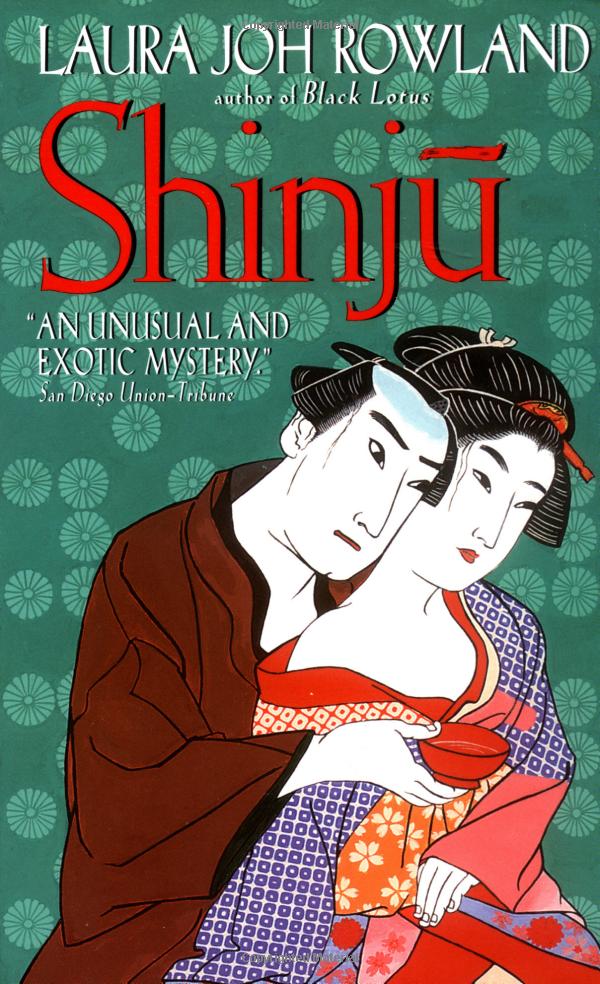Laura Joh Rowland
Books: Mystery | Historical
Sano Ichiro: Shinju (1994)
Sano Ichiro
Shinju (1994)
 It’s 1698 and Sano Ichiro is a yoriki, or magistrate who is assigned the case of a shinju–or ritual suicide to two star-crossed lovers.
It’s 1698 and Sano Ichiro is a yoriki, or magistrate who is assigned the case of a shinju–or ritual suicide to two star-crossed lovers.
Although he is pushed to close the case, something about the deaths bothers Sano, and he is determined to discover the truth of the deaths–no matter the cost.
A couple things about Shinju. This is the first book in a series, and I think it shows. By the end of the book, it seemed like just one more thing happened entirely too many times, to the point Sano was beginning to come across as a bit of a superhero. He made plenty of mistakes mind you, and didn’t seem to be a Mary Sue, but he just kept managing to be in the right place at the right time, and getting away just in the nick of time.
It just got to be a bit much.
The second thing is that although the setting was in Japan, the book still felt very Western to me. It’s not even anything I can put my finger on, after all, as far as I know the details of time and place are well done and correct. There was just something about the way Sano acted and thought that felt as though it were a westerner explaining what was happening.
However, aside from those flaws I kept reading, so it wasn’t all bad. And I have hopes that the next books in the series will have been tightened up a bit more.
RereadYoriki Sano Ichiro has been assigned to clear the case of a double-suicide. He has been given strict orders by his supervisor as what he is precisely to do. However, he is rather unsuited to following orders and instead looks into the death, which some suspect might have been murder.
This is a frustrating book.
I love the historical aspects, even if a specific time period isn’t given. There are guns, and the Shogun has forbidden the reading of Western literature, so that gives one a loose idea of the time. Which is find. Not giving a specific time period gives on more leeway.
Fifty years ago, the government had instituted a policy of strict isolation from the outside world. Iemitsu, the third Tokugawa shogun, had wanted to stabilize the country after years of civil war. Fearing that foreign weapons and military aid would allow various daimyo to overthrow his regime, he’d expelled the Portuguese merchants and missionaries and all other foreigners from Japan, and purged the country of all foreign influence. Only the Dutch were allowed trading privileges. Confined to the island of Deshima in Nagasaki Bay, the merchants were guarded day and night, their contact with the Japanese limited to the shogun’s most trusted retainers. To this day, foreign books were banned; anyone caught practicing foreign science faced harsh punishment.
The Way of the Warrior had undergone a subtle alteration in response to the changed times. Samurai still upheld honor, bravery, and loyalty as the highest virtues. They still carried swords and were responsible for keeping their fighting skills up to standard in the event of war. But in addition to swearing allegiance to a lord, they owed sometimes conflicting loyalties to a whole network of superiors, allies, and patrons, in addition to shogun and emperor. And while most samurai practiced the martial arts at academies such as the one Sano’s father operated, many didn’t.
All that is fascinating.
The mystery is also interesting, relating as it does to the politics of the time.
The problem is Sano. Well, not even him, really. He is interesting and likable and smart, even if he doesn’t know what he is doing.
The problem is that the resolution is an action movie one: no one believes Sano, so he does everything himself, saving the day.
Just… no. I hate that. It’s unrealistic and unbelievable and ridiculous.
I have other books, and I’ll try the next, but if the next had a ridiculous action hero ending, I’m done.
Publisher: Random House
- December 2008 | Rating: 6/10
- October 2017 | Rating: 5/10
